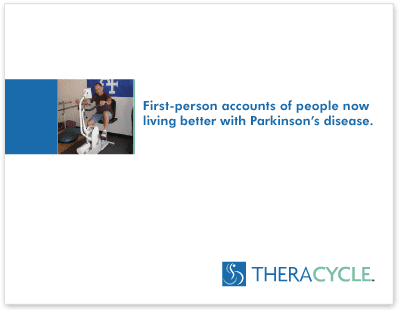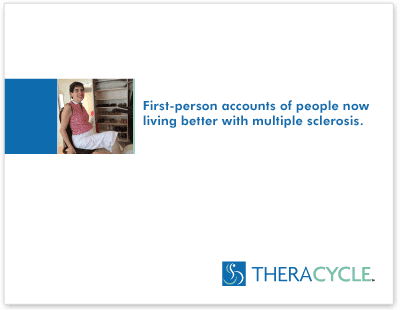- ›
- Stories
- ›
- Your Stories
- ›
- Parkinson’s Management: Harnessing the Power of Exercise
Stories
Parkinson’s Management: Harnessing the Power of Exercise

Exercise is your medicine! Do it EVERYDAY” [re+active] physical therapy and wellness
· by Sharon Krischer, August 4, 2017 | twitchywoman.com ·
By now, you know that I am a big fan of exercise. It has been a daily part of my life since I was young. Since my diagnosis with Parkinson’s, it has become not just something I enjoy, but something that I must do to keep on moving. I am sure that many of you feel that way as well. But for those of you who have never embarked on an exercise program, you need to speak to your Movement Disorders Specialist about how to begin. You may think that you cannot exercise because of limited movement or pain caused by PD. That was the prevailing theory 50 years ago. Today, however, we know that lack of exercise only makes things worse. You know the old adage: use it or lose it.
Scientists, such as Dr. Jay Alberts from the Cleveland Clinic Lerner Research Institute, have shown the benefits of forced exercise on PD. As a result, many physical therapists and trainers work with PD patients to improve motor function using forced exercise.
 We have been told that Neuroplasticity is crucial to either change or delay the progression of PD. And exercise is one of those activities that allows the brain to change. Exercise enables more of the dopamine in the brain to be used. It is important to exercise outside of your comfort zone. It increases blood flow to the brain and allows the neuroplasticity to occur. Goal directed exercise allows for these changes in the brain to occur. It improves the circuitry and improves the connection of the basal ganglia to the cortex.
We have been told that Neuroplasticity is crucial to either change or delay the progression of PD. And exercise is one of those activities that allows the brain to change. Exercise enables more of the dopamine in the brain to be used. It is important to exercise outside of your comfort zone. It increases blood flow to the brain and allows the neuroplasticity to occur. Goal directed exercise allows for these changes in the brain to occur. It improves the circuitry and improves the connection of the basal ganglia to the cortex.
Physical therapist, Allie Southam, from [re+active] physical therapy & wellness explained all of this in a fascinating talk last Sunday. Briefly:
- #1 reason for exercise: potential to slow the progression of PD through neuroplasticiy
- Find exercise that you love – otherwise you won’t do it
- Goal-directed motor skill training through acquisition of skills
- Learning a skill is hard, practice drives skill aquisition
- Getting feedback during exercise – allows us to challenge ourselves
and make ourselves aware ofour movements. What used to be automatic now requires us to think about what we are doing. It is also motivational
You can read a summary of her talk here.
Tom McLaughlin, a personal trainer whose wife, Linda, has PD, has been working on a training program to improve PD symptoms. He says that the brain is a learning machine. Because of dopamine depletion, we have cut off the connection between the brain and our muscles. The brain doesn’t know the connection is gone, so you have to go back and have your cognitive brain focus on motor function and motor skills. You have to overcome the “defect” in the brain through exercise.
 Tom’s exercise program tries to activate all of the muscles, and challenge them, in order to improve neuroplasticity in the brain. There are 16 steps to his program with the goal to work on 8 muscular functions on the top half of the body and 8 on the bottom. Those steps include working with each muscle group to move out to the side, the middle, forward and back, and to the 4 corners. Focusing on these 16 steps will help the brain reconnect with the body to return to more normal function.
Tom’s exercise program tries to activate all of the muscles, and challenge them, in order to improve neuroplasticity in the brain. There are 16 steps to his program with the goal to work on 8 muscular functions on the top half of the body and 8 on the bottom. Those steps include working with each muscle group to move out to the side, the middle, forward and back, and to the 4 corners. Focusing on these 16 steps will help the brain reconnect with the body to return to more normal function.
Both Allie and Tom stressed the words Focus and Learning. To improve your PD symptoms, you must focus on your movements to make them become automatic again, and you must learn new skills to increase the neuroplasticity in your brain.
About the Author
 Sharon Krischer was diagnosed with Parkinson’s Disease in October, 2009 after several years of experiencing odd symptoms. Ever since she has read everything she could find on Parkinson’s with the goal of finding a way to move on—literally—and not be defeated by the disease. A busy person prior to her diagnosis, she continues to find ways to fit more into her days than most people. Daily exercise is a key component for her to live successfully with PD. She continues to play tennis, badly, goes to yoga and boxing classes, travels around the world and more. In addition, she is often asked by friends to speak to a relative/friend/co-worker who has been newly diagnosed with Parkinson’s. As a result, Sharon started “Twitchy Woman’s Adventures with Parkinson’s” to encourage the exchange of ideas and solutions with other whose lives have been affected.
Sharon Krischer was diagnosed with Parkinson’s Disease in October, 2009 after several years of experiencing odd symptoms. Ever since she has read everything she could find on Parkinson’s with the goal of finding a way to move on—literally—and not be defeated by the disease. A busy person prior to her diagnosis, she continues to find ways to fit more into her days than most people. Daily exercise is a key component for her to live successfully with PD. She continues to play tennis, badly, goes to yoga and boxing classes, travels around the world and more. In addition, she is often asked by friends to speak to a relative/friend/co-worker who has been newly diagnosed with Parkinson’s. As a result, Sharon started “Twitchy Woman’s Adventures with Parkinson’s” to encourage the exchange of ideas and solutions with other whose lives have been affected.







